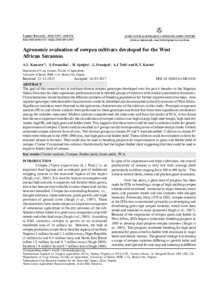| dc.contributor.author | Kamara, A.Y. |
| dc.contributor.author | Ewansiha, S.U. |
| dc.contributor.author | Ajeigbe, Hakeem A. |
| dc.contributor.author | Omoigui, L.O. |
| dc.contributor.author | Tofa, A.I. |
| dc.contributor.author | Karim, K.Y. |
| dc.date.accessioned | 2019-12-04T11:09:06Z |
| dc.date.available | 2019-12-04T11:09:06Z |
| dc.date.issued | 2017 |
| dc.identifier.citation | Kamara, A.Y., Ewansiha, S., Ajeigbe, H., Omoigui, L., Tofa, A.I. & Karim, K.Y. (2017). Agronomic evaluation of cowpea cultivars developed for the West African Savannas. Legume Research 40(4): 669-676. |
| dc.identifier.issn | 0250-5371 |
| dc.identifier.uri | https://hdl.handle.net/20.500.12478/1976 |
| dc.description.abstract | The goal of this research was to evaluate diverse cowpea genotypes developed over the past 4 decades in the Nigerian
Sudan Savannas for their agronomic performance and to identify groups of cultivars with similar quantitative characters.
Characterization would facilitate the efficient synthesis of breeding populations for further improvement of cowpea. Also
superior genotypes with desirable characteristics could be identified and disseminated in the dry savannas of West Africa.
Significant variations were observed in the agronomic characteristics of the cultivars in this study. Principal component
analysis (PCA) and cluster analysis were performed on these genotypes and found that there were significant correlations
among the variables measured. Modern cultivars outperformed the older ones and from the results of PCA, it was found
that the most important variables for the classification of cowpea cultivars are high canopy, high seed weight, high total dry
matter, high HI, and high grain and fodder yield. This suggests that these traits could be used in selection index for genetic
improvement of cowpea. Cluster analysis resulted in 5 groups mostly corresponding to era of release except cluster I which
contained cowpea cultivars from all eras. Two distinct groups in clusters IV and V were identified. Cultivars in cluster IV
which were released in the 1990-2000 eras, had high grain and fodder yield. These cultivars could be evaluated on-farm for
eventual release to farmers. They could also be used in breeding program for improvements in grain and fodder yield of
cowpea. Cluster V contained two cultivars that distinctly had the highest fodder yield suggesting that they could be used to
improve fodder yield of cowpea. |
| dc.format.extent | 669-676 |
| dc.language.iso | en |
| dc.subject | Grain Legumes |
| dc.subject | Cluster Analysis |
| dc.subject | Cowpeas |
| dc.subject | Fodder Yield |
| dc.subject | Yield |
| dc.subject | Pca |
| dc.subject | Cultivars |
| dc.subject | Genotypes |
| dc.subject | Agronomy |
| dc.title | Agronomic evaluation of cowpea cultivars developed for the West African Savannas |
| dc.type | Journal Article |
| dc.description.version | Peer Review |
| cg.contributor.crp | Grain Legumes |
| cg.contributor.affiliation | International Institute of Tropical Agriculture |
| cg.contributor.affiliation | Université du Bénin |
| cg.contributor.affiliation | International Crops Research Institute for the Semi-Arid Tropics |
| cg.contributor.affiliation | Sierra Leone Agricultural Research Institute |
| cg.coverage.region | Africa |
| cg.coverage.region | West Africa |
| cg.coverage.country | Nigeria |
| cg.researchtheme | BIOTECH & PLANT BREEDING |
| cg.isijournal | ISI Journal |
| cg.authorship.types | CGIAR and developing country institute |
| cg.iitasubject | Agronomy |
| cg.iitasubject | Cowpea |
| cg.iitasubject | Genetic Improvement |
| cg.iitasubject | Grain Legumes |
| cg.iitasubject | Plant Breeding |
| cg.iitasubject | Plant Genetic Resources |
| cg.journal | Legume Research |
| cg.howpublished | Formally Published |
| cg.accessibilitystatus | Limited Access |
| local.dspaceid | 85437 |
| cg.targetaudience | Scientists |
| cg.identifier.doi | http://dx.doi.org/10.18805/lr.v0i0.8410 |

